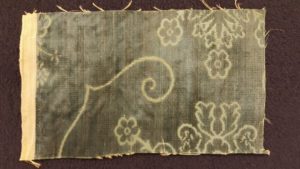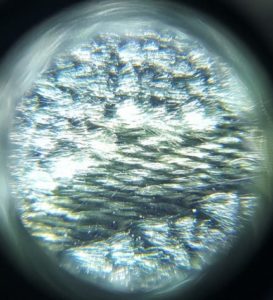By Assistant Curator/Collections Manager Megan Osborne
Velvet is one of the most luxurious fabrics ever woven, an elegant fabric coveted by kings and courtesans. Usually made of silk or cotton, with a dense, soft, and lustrous “pile” because of the way certain threads in the weave are cut, this distinctive textile has been used for centuries to communicate wealth, opulence and to signify extraordinarily special moments. A fabric featured in Renaissance portraits and royal coronations, velvet was even worn by The Beatles the first time they performed “Let it Be” in London.
An addition to the Avenir Museum

The Avenir Museum is now home to a small but exceedingly special piece of ciselé velvet (#2018.23.06), meaning that our example has a chiseled or embossed pattern made by the contrast of cut and uncut pile. Woven c. 1450-75 in one of the Italian city-states specializing in the manufacture of velvet, the piece measures 4⅝” by 7⅞”, including its ½-inch selvedge. The emerald green silk weft and a mustard gold warp produce a multidimensional green with an iridescent quality. A delicate spiral and small floral motifs materialize in the uncut areas shaped by the cut pile. The cut pile is so short that it is only visible under a microscope.

The Avenir Museum staff has long admired this small piece of velvet – perhaps the better word would be coveted. The first time we caught sight of it peeking out of a drawer was during a visit with textile collector and Avenir Museum supporter Carol Sarchet. Two years later, we are very appreciative that thanks to Carol’s generosity, this beautiful artifact of textile history has found a new home in the Avenir Museum’s permanent collection. Renaissance textiles – even small fragments such as this one – are difficult to find in the western United States, so this small, seemingly insignificant scrap of fabric will provide endless educational opportunities for CSU students to encounter a small portion of the textile heritage of the Italian Renaissance.
The Avenir Museum is part of the Department of Design and Merchandising in CSU’s College of Health and Human Sciences.